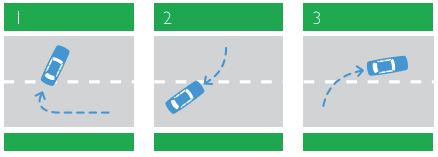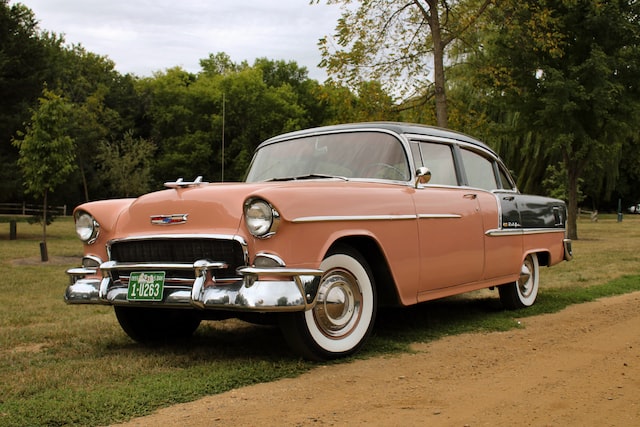Have you ever realized you’re going the wrong way and need to turn around? Few things are more annoying and time-consuming than driving in the wrong direction on a road with no available side streets to use to change directions. If you need to turn your car around in a tight space, you can use a simple move called the 3 point turn.
Both inexperienced and experienced drivers are afraid of making a three-point turn, but it doesn’t have to be that way. Follow this article to make sure your three points don’t turn into 30.
If you want to get more information, visit our website and try a free DMV practice test, or download it for your IOS or Android devices now!
What is a Three-Point Turn?

The three-point turn is a way for turning a vehicle around in the middle of the road. It is the standard way for turning a vehicle in the opposite direction on a road that is too narrow for a U-turn.
Because the safest way to turn on some roads may require more than three points, a three-point turn (also known as a two-point turn or “K-turn”) is officially named “a turn in the road.”
Most driver’s license examinations require you to successfully complete a 3-point turn (three-point turn). The three-point turn, like parallel parking, is a common cause of anxiety for those studying for their driver’s license. While most drivers only utilize this method when absolutely necessary, the ability to make a three-point turn is a crucial skill for all drivers. Make sure you practice doing a 3-point turn on a roadway with less traffic so you can take your time. It’s also a good idea to look for a place that’s free of ditches, mailboxes, or other large obstacles on either side.
When Should You Do a Three-Point Turn?
A 3-point turn takes longer than typical turns, and you’ll need enough room in both directions to properly complete the maneuver. Because many roads are too crowded to provide you with this amount of space, you must consider other cars before beginning the turn. A 3-point turn should not be made if it would cause traffic jams or is dangerous.
It may be preferable to do a U-turn or drive around the block rather than wait for a 3 point turn on any road with a steady flow of traffic.
How to Do a 3 Point Turn?
Here are Six 3 point turn steps that help you perform Three-point turns effectively and safely.
- Step 1: Make your way to the lane’s outer part
As you get closer to the spot where you’ll be practicing your first three-point turn, move to the outer part of the lane. You’ll have more room to maneuver your vehicle as a result of this.
- Step 2: Check your rearview mirror
Check your rearview mirror for traffic before stopping. On a busy road, avoid making a three-point turn. In fact, three-point turns should be employed only in an emergency. Finding a driveway or parking area to turn around in is safer and easier.
- Step 3: Look behind or in front of you for other vehicles
Stop your vehicle. Check for any other vehicles behind or in front of you once more. A three-point turn will take many seconds to complete. You don’t want to obstruct the road for other cars if at all possible, especially if you’re only doing a three-point turn for practice and not out of necessity.
- Step 4: POINT 1: Turn your driving wheel completely to the left and approach the opposing lane’s edge
Turn your steering wheel all the way to the left and speed your car until it approaches the edge of the opposing lane after stopping and checking there are no other vehicles approaching from either direction. This is the first point to mention.
- Step 5: POINT 2: Shift into reverse – turn the steering wheel to the right, and return to the side of the road where you started
Check for traffic once more. Put your car in reverse. Slowly turn your steering wheel to the right and begin backing your vehicle up to the edge of the road you started on, using your rearview and side mirrors. The second point is this.
- Step 6: POINT 3: Return to forward and turn left to begin driving in the opposite lane from where you started
Once more, keep an eye out for approaching automobiles. Return to forwarding gear and turn left to drive in the lane opposite the one you started in. The third and final point of the three-point turn driving move is this.
Read more >> How To Drive With A Trailer Safely?
Important things to keep in mind when doing a three-point turn
- Before starting the Point Turn, make sure you come to a complete stop at the kerb
- Before leaving the kerb, make sure you indicate your intent for at least 5 seconds
- Before making each direction change in a 3 Point Turn, make sure to look for other cars, pedestrians, and other obstacles
- During each direction change, make sure to glance in the direction of travel
- When exiting a three-point turn, make careful to indicate.
If you’re scared to make a 3 point turn because of the volume of traffic on the road, keep driving until you find a safer way to change your vehicle’s direction. You should be confident in your ability to complete a three-point turn after a few practice runs and have no issue demonstrating it during your driver’s license exam. If you ever need to turn your vehicle around in a tight area during an emergency, you’ll know that a three-point turn can be done swiftly and efficiently.

UT Utah License Renewal: A 2025 Comprehensive Guide
Discover the ultimate guide to Utah license renewal! This comprehensive guide delves into the intricacies of renewing your driver's license in Utah,...
February 13, 2023

South Carolina S.C. Driver's License Renewal
The South Carolina S.C. driver's license renewal process is designed to be comprehensive, taking into consideration eligibility requirements, renewal methods,...
February 13, 2023

Pennsylvania PA DMV License Renewal: A 2025 Full Guide
The Pennsylvania PA DMV license renewal process is designed to be comprehensive, taking into consideration eligibility requirements, renewal methods,...
February 10, 2023

